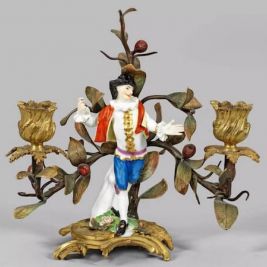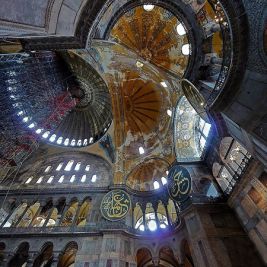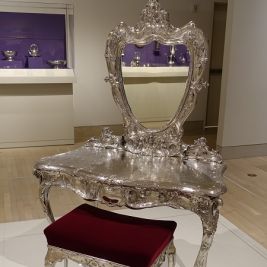
Hyperrealism - the perfect authenticity of artistic illusion
Hyperrealism or superrealism is a direction in painting, graphics, and sculpture of the late 20th to early 21st century, characterized by the maximum realistic accuracy of artistic images. Hyperrealistic works visually resemble high-quality photographs created using expensive, state-of-the-art photographic equipment.
 Hyperrealism. Emanuele Dascanio. Freedom?, 2014
Hyperrealism. Emanuele Dascanio. Freedom?, 2014
Hyperrealism is a style in which the artist pays great attention to the rendering of objects and details when creating a painting. The primary goal of the artist in this style is to create an illusionary, precise, and emotionally detached replication of the subject matter. In terms of its conceptual direction, hyperrealism shares many similarities with pop art, as both styles are popular variations of contemporary figurative art.
 Hyperrealism. Duane Hanson. Man on bench, 1977
Hyperrealism. Duane Hanson. Man on bench, 1977
Features of hyperrealism
Unlike the spiritually akin photorealism, hyperrealism has a distinctly noticeable emotional component. When working on a painting, drawing, or sculpture, the artist creates an extremely realistic artistic illusion of the object with impeccable surface texture, play of shadows, and lighting effects. This style is a complete opposite of conceptualism, where the author's idea is considered far more important than the means of artistic expression.
 Hyperrealism. Agustin Reche-Mora. Seville Street from the Jontanares Canteen to Alcalá Street, 1993
Hyperrealism. Agustin Reche-Mora. Seville Street from the Jontanares Canteen to Alcalá Street, 1993
Key features of hyperrealism include the following nuances:
- The use of photographic techniques to create and transfer the original image onto the canvas.
- A variety of materials used for sculptural creations.
- Significant dimensions of paintings.
- Widespread use of airbrush and glazing techniques in painting.
- High image resolution with meticulous rendering of every detail of the subject.
 Hyperrealism. Gottfried Helnwein. Epiphany I (Adoration of the Magi), 1996
Hyperrealism. Gottfried Helnwein. Epiphany I (Adoration of the Magi), 1996
Hyperrealist artists most often work in the genres of portraiture, landscape, or still life. In addition, within their community, there are also artists who prefer to create works of art on sharp social and political themes.
 Hyperrealism. Bernardo Torrens. Delai Necklace, 2001
Hyperrealism. Bernardo Torrens. Delai Necklace, 2001
To skillfully imitate color and black-and-white photographs, painting and graphic art masters employ various techniques and tools:
- Simple pencils and pastels.
- Sanguine and charcoal.
- Oil and acrylic paints.
- Ballpoint pens and aerosols.
 Hyperrealism. Ron Mueck. The man in the boat, 2002
Hyperrealism. Ron Mueck. The man in the boat, 2002
The History of Hyperrealism
The history of hyperrealism, as well as its close relative, photorealism, spans just over half a century and has its origins in the late 1960s. The emergence of these new styles can be attributed in large part to significant advancements in the technical capabilities of photography during that time. High-resolution cameras became available on the market, perfectly suited for producing high-quality photographs. This paved the way for creating paintings based on photographs using artistic techniques and tools.
 Hyperrealism. Ralph Goings. Still life with spoons, 2006
Hyperrealism. Ralph Goings. Still life with spoons, 2006
The term "hyperrealism" was first heard by the general public in 1973 at an eponymous exhibition in Brussels. The name for this new style was coined by the Belgian art dealer Isy Brachot. The exhibition became a significant event in European cultural life, showcasing the works of many American, German, French, and Italian masters of this emerging style. The hyperrealist pieces garnered considerable interest from critics and the public, although over the next decade, the mass enthusiasm for this ultra-modern art gradually waned.
 Hyperrealism. John Baeder. John's car outside John's diner, 2007
Hyperrealism. John Baeder. John's car outside John's diner, 2007
The second wave of interest in hyperrealism was sparked by the availability of widely accessible digital photography in the early 21st century. Compared to analog technologies, the resolution of photographs significantly improved. Artists finally had the opportunity to produce high-quality photos and use them as the basis for creating paintings and drawings.
 Hyperrealism. Magda Torres Gurza. Tea time, 2015
Hyperrealism. Magda Torres Gurza. Tea time, 2015
Today, hyperrealism is an essential part of contemporary visual art. Exhibitions of works by artists in this style consistently attract large crowds of spectators, and the finest pieces are eagerly purchased by patrons from various countries.
 Hyperrealism. Kelvin Okafor. Catherine's Interlude, 2016
Hyperrealism. Kelvin Okafor. Catherine's Interlude, 2016
The Most Famous Masters of Hyperrealism
Among the prominent representatives of this style, there are many interesting creative individuals living in different corners of the world. The most famous masters of hyperrealism include:
- Ron Mueck - the most renowned contemporary Australian hyperrealist sculptor. He effortlessly creates both small compositions and massive monumental works of art.
- Gottfried Helnwein - an Irish artist of Austrian origin who has gained worldwide recognition for his active social stance and the sharp social direction of his works. In his art, Helnwein often explores Holocaust-related themes.
- Emanuele Dascanio - a young Italian painter specializing in black-and-white paintings and portraiture.
- Bernardo Torrens - a Spanish painting master known for his magnificent portraits of men and women, detached from their natural environment. For Torrens, the ideal artist has always been his great compatriot Diego Velázquez.
 Hyperrealism. Carole Feuerman. The Midpoint, 2017
Hyperrealism. Carole Feuerman. The Midpoint, 2017
On the Very Important Lot portal, every visitor has a unique opportunity to participate in art auctions and acquire hyperrealism masterpieces. You can also directly purchase paintings from contemporary masters here.
 The painting "The Temptation of St. Anthony" by Hieronymus Bosch is a unique and mesmerizing work from the depths of centuries
The painting "The Temptation of St. Anthony" by Hieronymus Bosch is a unique and mesmerizing work from the depths of centuries  Special auction Faussner collection
Special auction Faussner collection  Schloss Ahlden: 190. Internationale Kunstauktion - Teil III
Schloss Ahlden: 190. Internationale Kunstauktion - Teil III  Icon - a sacred object in Christian culture: types, distinctive features, history
Icon - a sacred object in Christian culture: types, distinctive features, history  Byzantine art is a vast realm of unique artistic heritage of humanity
Byzantine art is a vast realm of unique artistic heritage of humanity  Architecture is an ancient art of creating magnificent monumental masterpieces
Architecture is an ancient art of creating magnificent monumental masterpieces  American Silver - From Colonial Times to the Present
American Silver - From Colonial Times to the Present  Sculpture "The Pietà" by Michelangelo Buonarroti is a iconic work in Catholicism
Sculpture "The Pietà" by Michelangelo Buonarroti is a iconic work in Catholicism  Battle genre in painting: heroic battles and anti-war pathos
Battle genre in painting: heroic battles and anti-war pathos  German Porcelain: History of Creation and Development
German Porcelain: History of Creation and Development